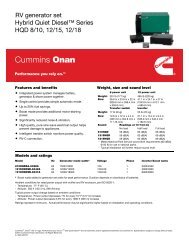Air Brake Manual
Air Brake Manual
Air Brake Manual
Create successful ePaper yourself
Turn your PDF publications into a flip-book with our unique Google optimized e-Paper software.
<strong>Air</strong><br />
inlet<br />
Previously illustrated are two common types of<br />
manual slack adjusters, showing the worm adjusting<br />
gear. When the brakes are fully applied, the angle<br />
between the push rod and the arm of the slack<br />
adjuster should be no more than 90° (at a right<br />
angle).<br />
<strong>Brake</strong> Chamber and Slack Adjuster (<strong>Brake</strong>s on)<br />
Pushrod<br />
90°<br />
Slack<br />
adjuster<br />
On manual slack adjusters, the adjusting worm bolt<br />
is turned until the brake linings touch the drums and<br />
then backed off, normally ˘ to ˚ a turn. A locking<br />
device, which may be a spring loaded collar over<br />
the head of the adjusting bolt, must be depressed<br />
when the wrench is slipped over the bolt head, this<br />
is known as a positive lock slack adjuster. Or they<br />
could use a spring-loaded internal check ball to lock the<br />
adjustment, and it must be removed to make any<br />
adjustment. This is known as a ball indent slack<br />
adjuster. The more often the driver checks the “slack,”<br />
the less the probability of brake failure. Vehicles rarely<br />
“lose” their brakes because of air loss; it is usually<br />
because they are out of adjustment.<br />
When conducting a pre-trip air brake inspection look<br />
for worn or damaged components, also ensure that the<br />
slack adjuster and push rod are at 90° with the brakes<br />
applied, as illustrated. If more than 90° there is a drastic<br />
loss in braking efficiency, less than 90° may indicate an<br />
over adjustment and brakes could be dragging.<br />
It is the driver’s responsibility to ensure that brakes are<br />
adjusted correctly. A simple service brake application<br />
at low speed to check brake adjustment is not<br />
adequate. Braking at highway speed causes brake<br />
drum expansion due to heat, which in turn requires<br />
greater push rod travel to maintain the same braking<br />
force. If a brake is out of adjustment there would not be<br />
enough reserve stroke of the push rod travel to<br />
compensate for drum expansion. This would cause a<br />
brake fade and would greatly extend stopping distance.<br />
If travelling down a hill, this could cause complete<br />
brake loss.<br />
Note: Detailed brake adjustment procedures are outlined<br />
in Section Eight.<br />
Automatic Slack Adjuster<br />
Clevis pin (large)<br />
Clevis<br />
Clevis pin (small)<br />
Actuator rod<br />
Hairpin clip<br />
Housing<br />
Roller (pin)<br />
Boot and strap<br />
Actuator (adjusting sleeve)<br />
Actuator piston<br />
Pressure relief capscrew (pull pawl)<br />
Thrust washer<br />
Grease groove<br />
Grease fitting<br />
Worm gear<br />
18<br />
Pawl spring<br />
Adjusting pawl<br />
Worm<br />
Worm seal<br />
Adjusting bolt




